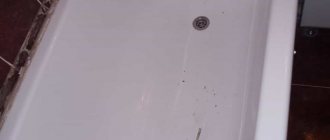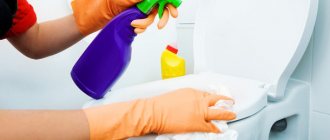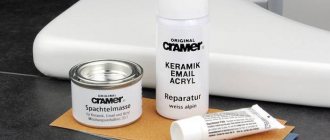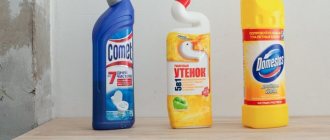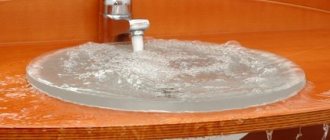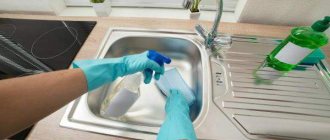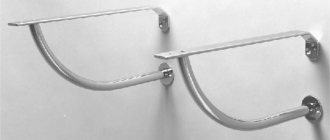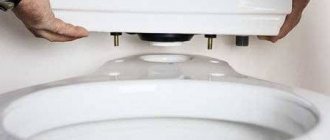Why does the bathroom get dirty?
Regardless of the type and composition of the snow-white base, the reasons for contamination of the paint surface can be both natural hair products and chemicals for body care, of which there are a very large number in modern cosmetics. Often ordinary tap water with the salts and chlorine it contains also acts as pollutants.
There are two ways to lighten a bathtub - by removing plaque or bleaching it.
To cope with each of them, you need to have on hand the most common housewife tool - washing sponges and working solutions. Most often, the necessary product can be found at hand; there are also professional materials sold in specialized stores.
Before you start cleaning, check what material the bathtub is made of.
Before you clean the stains, it is useful to have an idea of what they actually are.
Bottom line
Everyone knows the wisdom that any problem is easier to prevent, so we adjust our methods of caring for the device so that later we don’t have to shed burning tears over a ruined bathtub.
- After each use, rinse the bowl and wipe dry.
- Wash it every day with a mild specialized composition or dishwashing detergent.
- Remove any dirt immediately, without allowing it to “eat” into the surface.
- Install a pre-filter to remove impurities and rust from tap water.
But if trouble could not be avoided, and unsightly stains, plaque and rust still settled in your font, do not be upset. Now you know what and how to do to make the product white again.
If you have your own bathroom whitening method, then don’t be shy and share your secret in the comments!
Types of bath contamination
All visible pollution is usually divided according to the nature of the reasons that caused its appearance.
A clogged drain will negate all the effort spent on cleaning the bathtub. Hard water. A high concentration of salts in the water used for bathing has the most negative effect on the acrylic or enamel of the bathtub. After them, the surface ceases to be glossy and gradually turns into a loose and unsightly layer. The pores that form on the surface actually begin to trap dirt and remnants of chemicals used in bathing on the surface.
Note! Too hard water is harmful not only to the bathroom coating, but also to human skin.
Over time, the enamel of the bathtub becomes covered with plaque, rusty spots and begins to darken.
High chlorine content in water. Modern water treatment plants continue to use chlorine as their primary method of combating harmful bacteria and microorganisms. Without completely dissolving in water, such compounds linger on the snow-white surface of the bath, destroying it. Elements made of liquid acrylic and plastic suffer especially greatly from such impurities.
In production, bathtubs are made from a material that does not change its color over time.
Rust or yellowing. Many urban communications of modern cities are still in a deplorable state, and rust appears from time to time as one of the polluting factors in the bathroom. It is especially dangerous if the enamel has previously been damaged by other substances, then the rust actually eats into the paint layer, forming unsightly orange smudges.
Yellow plaque initially manifests itself in the area of the drain hole.
Also, if the base of the bathtub is made of steel or cast iron, water can penetrate through microcracks in the enamel layer, coming into contact with the metal and causing oxidative reactions. They will also result in unsightly rust stains.
The main reason for the appearance of stains is the quality of the supplied water.
Soap deposits. It is recommended to wash off all remaining dirt from the surface of the bath after each use. Otherwise, over time, plaque will certainly begin to form on the acrylic or enamel of the bathtub. And because of its alkaline composition, soap will only speed up this process.
The most effective and best remedy is the one prepared with your own hands at home.
The use of dyes in household chemicals. Such dyes are certainly present in all hair products, shower gels, shampoos and even liquid soap. Accumulating over time, they turn the snow-white surface into an obscene appearance.
Note! Many folk remedies have the greatest coloring effect on the surface of the bath - decoctions of oak bark, onion peels, turmeric, walnuts and saffron.
Special cleaning products
Special compositions of cleaning products are specially developed to achieve the best effect and guarantee at least a result no worse than traditional ones. However, their improper use can cause more harm, because all such solutions use an aggressive chemical base, which may well cause negative consequences.
SIF - necessary for whitening the bath.
Therefore, before you start using any professional product, you must carefully study its instructions and strictly follow them.
The most well-known and effective means, which can also be purchased at almost any department store, are:
- Acrilan.
- Frosch.
- Unicum.
- Cif.
There are many white bath products available today.
The above products are available in the form of gels and foams for cleaning the bathtub, however, for severe stubborn dirt, it is recommended to use compositions such as Cilit Bang or Pemolux. Remember that they are not suitable for preventive care due to their high chemical activity in the case of Cilit,
Ideally, the bathroom should sparkle with tiles and snow-white fixtures.
Pemolux is a powder that is not recommended for use on minor stains due to the risk of damaging the glossy surface of the bathtub.
Effective folk remedies for cleaning
In addition to a wide selection of professional products, there are also a number of folk recipes that recommend using commonly available table ingredients such as vinegar, soda or citric acid as the main materials for cleaning the bathtub.
Time passes and the enamel of the bathtub begins to darken, becoming covered with stains and rusty stains.
We will talk about these and some other equally effective means further.
Vinegar
Regular table vinegar is an excellent tool not only for cleaning, but also for disinfecting the surface of the bathtub. Moreover, to obtain an acceptable effect, a 9% solution is quite enough; it is not at all necessary to take a concentrated essence.
To whiten a bathtub, you first need to rinse it.
With its help, you can remove not only salt or lime deposits from the surface, but also disinfect against fungus and other harmful microorganisms. When using this product, the following methods are used.
- Vinegar bath. Add a liter of vinegar to a whole bath of warm water and leave the resulting solution for 6-12 hours.
- Vinegar lotions. As the name implies, pour a little 9% solution onto a small piece of gauze, cotton wool or paper and leave for 6-8 hours. This way it is possible to remove both rust and strong alkaline deposits.
- A mixture of baking soda and vinegar with bleach. Due to its high toxicity, we recommend cleaning with this solution wearing protective gloves, goggles and a mask. And because of its high aggressiveness, this method is suitable for old stains that could not be removed with more gentle recipes. First, the bath is pre-washed with running water and treated with a mixture of salt, water and soda. After 10 minutes, pour a mixture of table vinegar and bleach in equal parts over the powder layer. After another 30 minutes, add a little soda to enhance the reaction and wash off the remaining product from the surface with a household sponge. After another 5-7 minutes, the process can be considered complete; the bath can be used only after thoroughly rinsing the surface with water.
Note! For this method, it is recommended to cover the surface of the bath with a layer of film to prevent toxic vinegar from evaporating into the room.
Use different products to whiten your bathtub.
Soda
Baking soda itself works well as a mild cleaning powder, which means it can be used to clean bathtub enamel with minor stains.
Baking soda is a good stain remover for white items.
A better effect can be achieved if you use it in a mixture with soap or acids, for example, vinegar. However, it is important to observe the time (on average no more than 30 minutes) for keeping such a composition on the paint surface.
Lemon acid
Citric acid, which can be found either in the juice of fresh lemons or in powder dissolved in water, can remove the following types of contaminants:
- lime;
- rust;
- yellowing of the enamel.
Citric acid is ideal for cast iron bathtubs.
Lemon juice is used in a 1:1 ratio with water; it is better to give such liquid time to begin to have an effective effect - usually 10 minutes is enough. If you decide to use citric acid in powder, add 2 tablespoons of the substance to a glass of water and use it mainly with pre-soaking.
You can whiten a cast iron bathtub at home using homemade mixtures.
Oxalic acid
This remedy, although classified as folk, is often used in professional cleaning. Acid should be used with extreme caution - a concentration higher than the recommended 5% can give a much more negative result than benefit.
Oxalic acid is suitable for simple stains.
Leave the acid on the surface of the stain for 1-2 hours, and then remove it with liquid soap.
Acrylic coated sanitary ware
Cleaning an acrylic bathtub is somewhat different from enamel surfaces that are more resistant to mechanical and chemical influences. First of all, it is necessary to exclude the use of aggressive cleaning agents, including industrial acids, not to mention various types of solvents. Using washing powder will cause acrylic to fade. It takes on a gray or slightly yellowish tint, which is especially noticeable next to the shiny surface of new plumbing fixtures.
- Citric acid and apple cider vinegar. Dilute a tablespoon of citric acid in 200g of water and mix with the same amount of vinegar (7–11%). Apply the prepared solution to the dirt. Old brown rust may require bleaching by using wipes or towels soaked in the mixture to soak the stains for a long time. In any case, wait at least an hour, then wash off with water. If the first time it was not possible to achieve the desired result, repeat the procedure. At the end, you should normalize the acidity by wiping the surface with any alkaline composition, and then rinse it off with a small amount of water.
- An alternative method is using vinegar. To restore the whiteness of the acrylic surface, fill the bath with water, covering the contaminated areas and add vinegar in a ratio of 1:20 for 11% of the product. Leave it overnight, then rinse with warm water.
How to properly wash and care for an acrylic bathtub - video:
Minor stains from the acrylic surface can be easily removed with ordinary dishwashing detergent; in addition, you can use any gentle gel-like mixtures. If you do this regularly, you won’t have to remove stubborn traces of rust.
Cleaning an acrylic bathtub
When cleaning this type of bathtub, it is strictly forbidden to use substances that can dissolve plastic. Therefore, we carefully read the instructions for the professional product, and also do not deviate from the recommendations for folk remedies.
Acrylic coating is a relatively new material that has quickly gained popularity.
It is best to clean an acrylic bathtub with a weakly acidic solution - vinegar, oxalic acid, avoiding prolonged exposure to the surface. The use of powders is prohibited; they can cause great harm to the surface.
Modern cast iron and metal bathtubs may also have an acrylic coating.
Before bleaching an acrylic bathtub at home, it is recommended to first test the selected product in an inconspicuous place of the bathtub, for example, a side bend. And if such a test does not show any negative results, work can continue.
Useful tips
Experienced housewives recommend that before starting work aimed at eliminating stains in the bathtub, you should familiarize yourself with several useful tips. They will help you carry out cleaning procedures as efficiently as possible and avoid mistakes:
- Before washing a yellowed surface, it is important to pay attention not only to the materials offered for cleaning, but also to what type of bathtub they are recommended for (for example, what is suitable for a cast-iron bathtub may not be suitable for an acrylic one at all);
- The use of hard metal brushes is not allowed, as they provoke the appearance of cracks, which will subsequently increase, worsening the appearance of the bathroom and significantly reducing its service life;
- It is undesirable to use bath cleaning products if they contain sebaceous acids (such products are prohibited for acrylic bathtubs);
- It will be possible to prevent the occurrence of plaque if, after each bathing, the bath is rinsed with warm water, thanks to which the remaining detergents are washed off, preventing the formation of a film.
Whitening a cast iron bathtub
Cast iron is covered with an enamel layer, which requires cleaning over time. Here you can use almost any product, because enamels for such baths are quite durable. The question of how to whiten a cast-iron bathtub at home is not as complicated as it seems.
A cast iron bathtub is famous for its ability to maintain water temperature for a long time.
A combination of several products is best suited - soda with vinegar, oxalic acid, special products for enamel surfaces, mentioned earlier.
How to whiten a steel bathtub
Steel bowls, like cast iron, are coated with a thin layer of enamel . When damaged, low-carbon iron alloys corrode faster than high-carbon ones, so steel baths are prone to spot yellowing in areas of scratches, punctures and chips of the coating.
Folk remedies
Effective cleaning methods include:
- Wash with a mixture of salt and turpentine. Mix 40-50 ml of turpentine and 5-6 tbsp. finely ground salt. Apply to darkened enamel, rub and leave for 10-20 minutes. Rub again and rinse off the mixture.
- Soaking in Coca-Cola. This drink contains phosphoric acid, which is used to remove oxides. To get rid of limescale, rust and stains, you need to cover the dirty areas with gauze soaked in Coca-Cola, leave for 1-2 hours and rub with a sponge. Wash the clean surface and wipe with a dry cloth.
For steel bowls, you can also use products recommended for cast iron baths.
Purchased funds
For a steel bath, any cleaner designed for enamel surfaces is suitable. If the product is recommended for earthenware and ceramics, then it can only be used for washing toilets, sinks and tiles.
To avoid scratches, you need to choose mild forms of chemicals: foams, creams, gels, sprays and liquids.
How to clean a heavily stained bathtub
If cleaning work is planned to be carried out on a heavily soiled bath, it should be divided into several separate stages. The first step is to remove traces of rust, after which you can proceed to the treatment of alkaline deposits.
If you want to achieve really good results, you will have to perform a whole cycle of washing operations.
Everyone can decide for themselves how to whiten a bath; you just need to carefully re-read the review of the most effective means offered above.
How to avoid mistakes
Most often, errors arise due to non-compliance with the holding time of cleaning agents and solutions on the surface. Therefore, for professional liquids, we carefully read the instructions for their use, and for equally effective folk remedies, we use the recommendations of this material.
Enamel loses its whiteness faster than other materials and becomes dull and gray.
It is also worth remembering that enamel and acrylic are materials with different properties and must be cleaned in accordance with the recommendations.
Features and Recommendations
Before starting work, determine the material of the product, the degree of contamination and service life.
Steel baths
The enamel is thinner than that of cast iron plumbing.
You can clean it with the same means, lowering the concentration and shortening the exposure time of the drug.
Do not use hard materials or metal brushes for cleaning.
Cast iron products
They tolerate abrasive cleaning agents and aggressive cleaners well.
Acrylic products
The main disadvantage is the fragile coating. It is recommended to clean and bleach only with special gentle compounds.
How often do you need to clean the bathtub?
In modern plumbing conditions, it is recommended to rinse it clean every time after taking a bath, and wash it with cleaning powder at least twice a month. Of course, if the bath is used more intensively, prevention should also be carried out more often.
If folk remedies are not suitable for some reason, you can go to the store and purchase specialized household chemicals.
But for a family of three, one cleaning every two weeks will provide the bathtub cover with a long period of brilliant (in every sense) service.
Advantages of cast iron products
The increased popularity is easily explained by the characteristics of seemingly outdated plumbing fixtures.
Cast iron baths are recognized by WHO as safe for human health.
The metal is not subject to deformation as a result of mechanical stress. The minimum warranty period declared by manufacturers is 10 years. But the product can be used for 70–80 years or more.
The material is able to maintain temperature three times longer than acrylic.
The material is resistant to chemical, physical and mechanical stress. Withstands high temperatures.
Metal has a soundproofing effect and is able to absorb extraneous noise, such as falling water.
How to care for your bathroom
The main methods of care include the already mentioned rinsing after each use of water procedures, as well as maintaining its surface in its original form. And even if pollution appears, you can deal with it in just a few steps, thanks to the information from this article.
It is simply necessary to bleach the bathtub, because this particular part of the apartment is one of the signs of a good housewife or owner.
Maintaining a bathtub in its original form is not as difficult as it seems, and if you suddenly need to whiten its surface, the recommendations of this material will come in handy.
How to remove limescale?
The above recipes clean limescale well, since acids are the main helpers in the fight against porous deposits on the walls of the bathtub. In case of moderate contamination, it is quite enough to treat the bath several times in a row.
- How to clean a bathtub from water stone if vinegar and citric acid did not do the job?
You can try a new product - a melamine sponge, the soft abrasive effect of which has many positive reviews on the Internet. Frozen crystals of melamine resin, slightly soluble in water - this is a melamine sponge. Before use, the sponge must be moistened and wrung out. The cleaning method is mechanical; you need to rub the areas especially affected by plaque with this sponge. In this case, the sponge itself will be erased, and the surface will be cleaned.
In especially severe cases, hydrochloric acid will help out. Gently apply a small amount of hydrochloric acid only to the areas affected by scale. Once the desired effect is achieved, rinse with plenty of water. The main thing is not to abuse it and take precautions.
After using cleaning products containing acids, we recommend treating the walls of the bathtub with a mild soap solution, rinsing with water and wiping dry.

